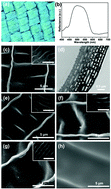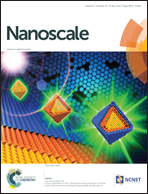Hierarchical photonic structured stimuli-responsive materials as high-performance colorimetric sensors†
Abstract
Hierarchical photonic structures in nature are of special interest because they can be used as templates for fabrication of stimuli-responsive photonic crystals (PCs) with unique structures beyond man-made synthesis. The current stimuli-responsive PCs templated directly from natural PCs showed a very weak external stimuli response and poor durability due to the limitations of natural templates. Herein, we tackle this problem by chemically coating functional polymers, polyacrylamide, on butterfly wing scales which have hierarchical photonic structures. As a result of the combination of the strong water absorption properties of the polyacrylamide and the PC structures of the butterfly wing scales, the designed materials demonstrated excellent humidity responsive properties and a tremendous colour change. The colour change is induced by the refractive index change which is in turn due to the swollen nature of the polymer when the relative humidity changes. The butterfly wing scales also showed an excellent durability which is due to the chemical bonds formed between the polymer and wing scales. The synthesis strategy provides an avenue for the promising applications of stimuli-responsive PCs with hierarchical structures.


 Please wait while we load your content...
Please wait while we load your content...